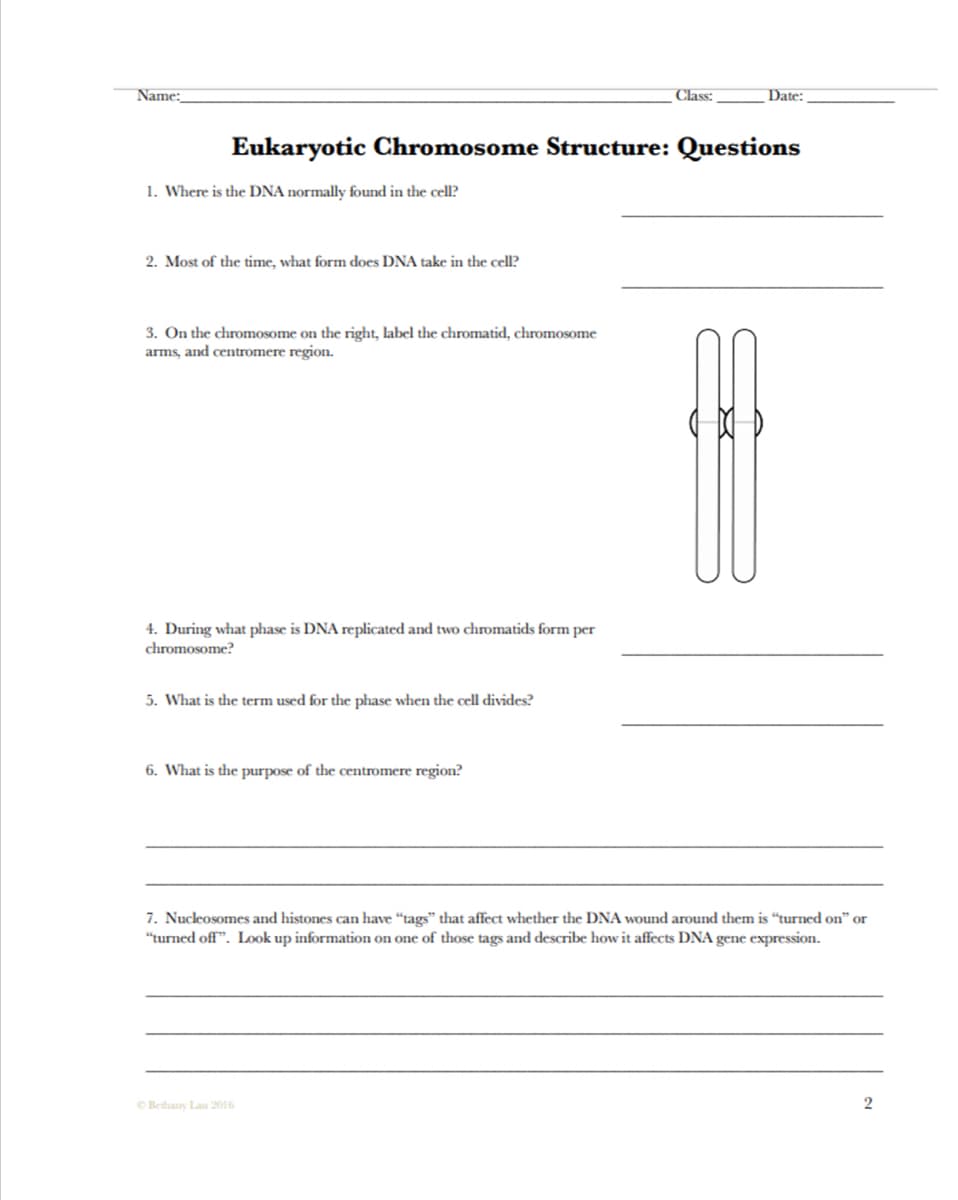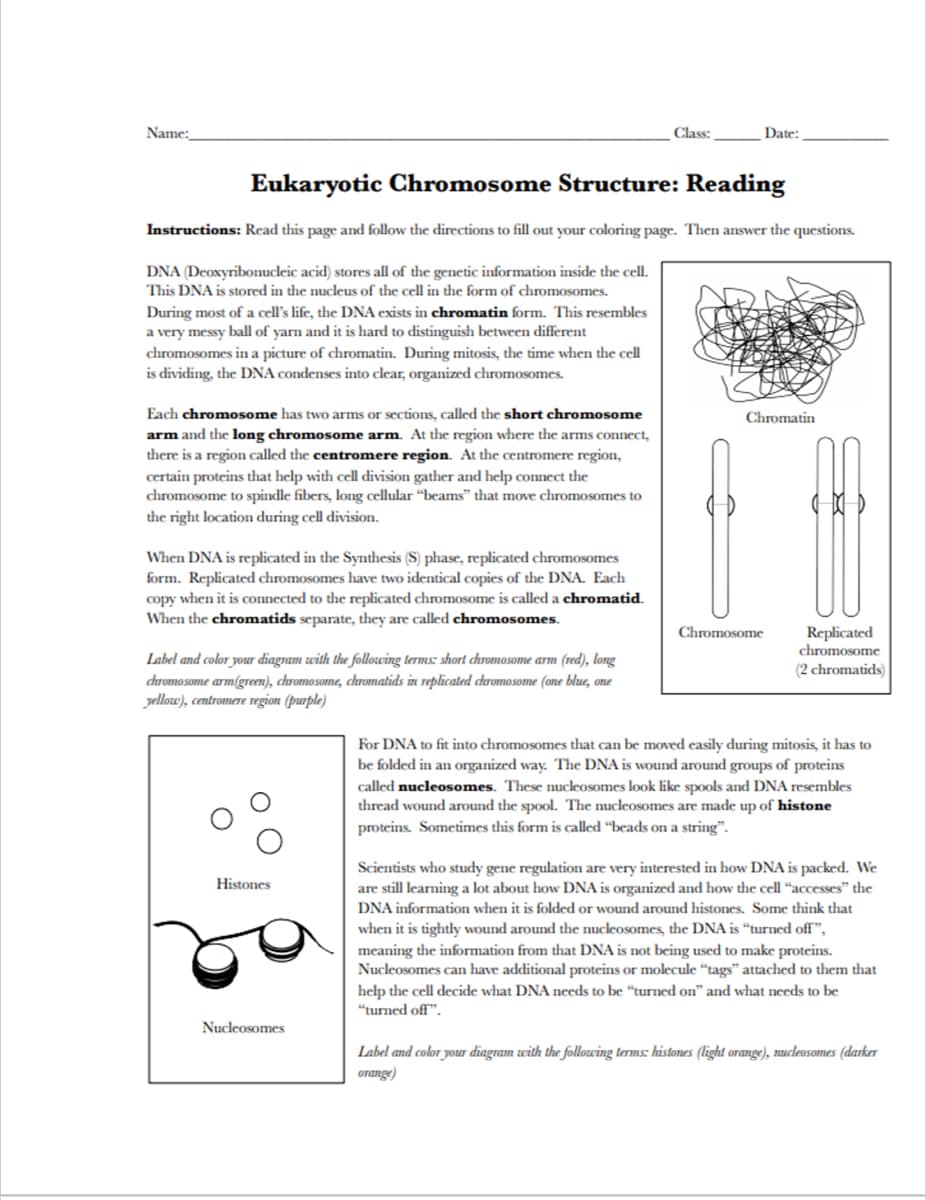Name: Class: Date: Eukaryotic Chromosome Structure: Questions 1. Where is the DNA normally found in the cell? 2. Most of the time, what form does DNA take in the cell? 3. On the chromosome on the right, label the chromatid, chromosome arms, and centromere region. 4. During what phase is DNA replicated and two chromatids form per chromosome? 5. What is the term used for the phase when the cell divides? 6. What is the purpose of the centromere region? 7. Nucleosomes and histones can have "tags" that affect whether the DNA wound around them is "turned on" or "turned off". Look up information on one of those tags and describe how it affects DNA gene expression.
Name: Class: Date: Eukaryotic Chromosome Structure: Questions 1. Where is the DNA normally found in the cell? 2. Most of the time, what form does DNA take in the cell? 3. On the chromosome on the right, label the chromatid, chromosome arms, and centromere region. 4. During what phase is DNA replicated and two chromatids form per chromosome? 5. What is the term used for the phase when the cell divides? 6. What is the purpose of the centromere region? 7. Nucleosomes and histones can have "tags" that affect whether the DNA wound around them is "turned on" or "turned off". Look up information on one of those tags and describe how it affects DNA gene expression.
Human Biology (MindTap Course List)
11th Edition
ISBN:9781305112100
Author:Cecie Starr, Beverly McMillan
Publisher:Cecie Starr, Beverly McMillan
Chapter18: Cell Reproduction
Section: Chapter Questions
Problem 6SQ: After mitosis, each daughter cell contains genetic instructions that are ______ and _____ chromosome...
Related questions
Question
The first picture is the reading and can you PLEASE NOT TYPE THE ANSWER CAN TOU WRITE IT ON A PAPER THE ANSWERS

Transcribed Image Text:Name:
Class:
Date:
Eukaryotic Chromosome Structure: Questions
1. Where is the DNA normally found in the cell?
2. Most of the time, what form does DNA take in the cell?
3. On the chromosome on the right, label the chromatid, chromosome
arms, and centromere region.
4. During what phase is DNA replicated and two chromatids form per
chromosome?
5. What is the term used for the phase when the cell divides?
6. What is the purpose of the centromere region?
7. Nucleosomes and histones can have "tags" that affect whether the DNA wound around them is “turned on" or
"turned off". Look up information on one of those tags and describe how it affects DNA gene expression.
OBethany Lau 2016

Transcribed Image Text:Name:
Class:
Date:
Eukaryotic Chromosome Structure: Reading
Instructions: Read this page and follow the directions to fill out your coloring page. Then answer the questions.
DNA (Deoxyribonucleic acid) stores all of the genetic information inside the cell.
This DNA is stored in the nucleus of the cell in the form of chromosomes.
During most of a cell's life, the DNA exists in chromatin form. This resembles
a very messy ball of yarn and it is hard to distinguish between different
chromosomes in a picture of chromatin. During mitosis, the time when the cell
is dividing, the DNA condenses into clear, organized chromosomes.
Each chromosome has two arms or sections, called the short chromosome
arm and the long chromosome arm. At the region where the arms connect,
there is a region called the centromere region. At the centromere region,
certain proteins that help with cell division gather and help connect the
chromosome to spindle fibers, long cellular “beams" that move chromosomes to
the right location during cell division.
Chromatin
When DNA is replicated in the Synthesis (S) phase, replicated chromosomes
form. Replicated chromosomes have two identical copies of the DNA. Each
copy when it is connected to the replicated chromosome is called a chromatid.
When the chromatids separate, they are called chromosomes.
Chromosome
Replicated
chromosome
Label and color your diagram with the following terms: short chromosome arm (red), long
chromosome arm(green), chromosome, chromatids in replicated chromosome (one blue, one
yellow), centromere region (purple)
(2 chromatids)
For DNA to fit into chromosomes that can be moved easily during mitosis, it has to
be folded in an organized way. The DNA is wound around groups of proteins
called nucleosomes. These nucleosomes look like spools and DNA resembles
thread wound around the spool. The nucleosomes are made up of histone
proteins. Sometimes this form is called “beads on a string".
Scientists who study gene regulation are very interested in how DNA is packed. We
are still learning a lot about how DNA is organized and how the cell “accesses" the
Histones
DNA information when it is folded or wound around histones. Some think that
when it is tightly wound around the nucleosomes, the DNA is “turned off",
meaning the information from that DNA is not being used to make proteins.
Nucleosomes can have additional proteins or molecule “tags" attached to them that
help the cell decide what DNA needs to be “turned on" and what needs to be
"turned off".
Nucleosomes
Label and color your diagram with the follozwing terms: histones (light orange), mucleosomes (darker
orange)
Expert Solution
This question has been solved!
Explore an expertly crafted, step-by-step solution for a thorough understanding of key concepts.
This is a popular solution!
Trending now
This is a popular solution!
Step by step
Solved in 2 steps with 1 images

Knowledge Booster
Learn more about
Need a deep-dive on the concept behind this application? Look no further. Learn more about this topic, biology and related others by exploring similar questions and additional content below.Recommended textbooks for you

Human Biology (MindTap Course List)
Biology
ISBN:
9781305112100
Author:
Cecie Starr, Beverly McMillan
Publisher:
Cengage Learning

Human Heredity: Principles and Issues (MindTap Co…
Biology
ISBN:
9781305251052
Author:
Michael Cummings
Publisher:
Cengage Learning

Biology Today and Tomorrow without Physiology (Mi…
Biology
ISBN:
9781305117396
Author:
Cecie Starr, Christine Evers, Lisa Starr
Publisher:
Cengage Learning

Human Biology (MindTap Course List)
Biology
ISBN:
9781305112100
Author:
Cecie Starr, Beverly McMillan
Publisher:
Cengage Learning

Human Heredity: Principles and Issues (MindTap Co…
Biology
ISBN:
9781305251052
Author:
Michael Cummings
Publisher:
Cengage Learning

Biology Today and Tomorrow without Physiology (Mi…
Biology
ISBN:
9781305117396
Author:
Cecie Starr, Christine Evers, Lisa Starr
Publisher:
Cengage Learning
